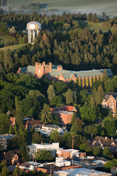I-Safety
Spotlight Tips of the Week
It's officially spring, and time to think about putting winter safety gear aside for another season. If you use studded snow tires, remember that the last day for using these tires in Idaho is April 30. Even if it is still a legal time to use them, the metal cleats embedded in the tread can cause unnecessary wear on bare roadways. The Idaho Transportation Department encourages removing studded snow tires when conditions allow, which may be earlier than April 30.
If you are traveling, it's important to know that studded tire laws vary in neighboring states:
- Montana: Oct. 1 - May 31
- Nevada: Oct. 1 - April 30
- Utah: Oct. 15 - March 31
- Oregon: Nov. 1 - March 31
- Washington: Nov. 1 - March 31
- Wyoming: Legal all year
While you're having your studded winter tires removed, it's a great time to have your alignment checked. Proper wheel alignment contributes to better fuel economy, handling and even tire wear.
Flash floods and rising waters can occur quickly and are not uncommon on the Palouse this time of year. Please be wise about your actions when weather reports predict the possibility of this happening. Warning signs: unusually hard rain over several hours; steady substantial rain over several days; and rains in conjunction with a spring thaw.
If water is backing up on Paradise Creek as it flows across campus—typically near culverts—report the concern to Facilities (208-885-6246) and Environmental Health and Safety (208-885-6524).
Precautions to take: although these seem obvious, they are important!
- Remain aware and monitor local radio, television and go online for up-to-date National Weather Service alerts. If flash floods are possible, move to higher ground.
- Be watchful at bridges and low areas that could have rushing water and over running banks, especially Paradise Creek in Moscow.
- Avoid flood waters and fast moving creeks and rivers. Don't walk or drive into moving water. Just inches of moving water can knock you down. Read more about flood safety.
- Refrain from kayaking, inner tubing or doing any other water activity during flood conditions. Floodwater may be contaminated with oil, gasoline or raw sewage. Floodwater may also be charged with electricity from fallen power lines.
- Almost half of all flash flood deaths happen in vehicles. Moving water is very easy to underestimate. Driving through any sort of moving water can sweep your car right off the road, even in seemingly mild flooding as shallow as a few inches.
Campus Contacts
Emergency Numbers for: Boise, Coeur d’Alene and Idaho Falls Campuses
Moscow
- Campus Security (24/7): 208-885-7233 (SAFE) | campus-security@uidaho.edu
- Environmental Health and Safety: 208-885-6524
- Facilities (office hours): 208-885-6246
- Facilities (after hours): 208-885-7233
- Parking and Transportation Services: 208-885-6424
- Public Safety and Security: 208-885-2254
- Recorded Emergency Updates: 208-885-1010
- Safe Walk (24/7): 208-885-7233 (SAFE)
- Vehicle Assistance (Pit Crew) Monday-Friday: (office hours) 208-885-6424 or (4:30-9 p.m.) 208-885-7233 (SAFE)
University of Idaho Emergency Response Team
The University of Idaho maintains an Emergency Response Team (UIERT) through the office of Environmental Health and Safety. This team’s purpose is to provide rapid response to incidents that threaten lives, property and/or the environment, including chemical, radiological and biohazardous incidents.
The UIERT, comprised of all members of EHS, is trained and equipped to handle most incidents that may occur on campus. All team members have completed, at a minimum, a 40-hour hazardous waste operations and emergency response (HAZWOPER) course as well as FEMA training in Incident Command and are ready to respond to small and major incidents. The UIERT maintains an Emergency Response Vehicle (ERV) which is fully stocked and ready to use at a moment’s notice.
The team responds to about 9 incidents of any size per year; these are mostly small incidents. The last major response was in June 2018 for a major oil spill at the dairy farm. A dump truck caught on overhead lines, pulling down two attached power poles which had 3 transformers on each and resulted in a spill of approximately 100 gallons total of mineral oil. The team worked long hours in the sun to capture the spilled oil from the pavement and dig up barrels of contaminated soil to protect the environment.
The team also has an agreement with the City of Moscow to respond to other incidents in the city as requested. This service is activated as needed by the Incident Commander acting for the City of Moscow and may be initiated by calling 911.The team continuously collaborates with the state of Idaho Fire Marshal, Moscow Volunteer Fire Department, Idaho Department of Environmental Quality, and Washington State University to share information, plan incident responses and participate in training.






